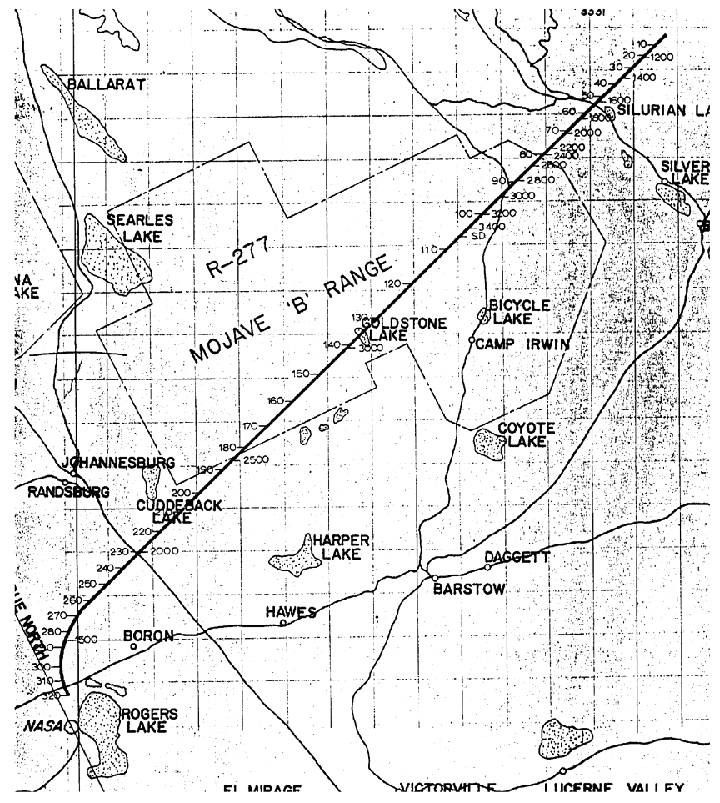
Flight No.: 3-1-1 Scheduled Date : December 15, 1961
Pilot: Neil Armstrong
Subject of test: Evaluation of MH-96 FCS adaptive control system and first flight of X-15-3.
Airplane configuration: Basic X-15-3 with XLR-99 and MH-96 FCS
Launch: Silver Lake
on a magnetic heading of 243°, MH-96 FCS on "adaptive damper," adaptive
reaction controls OFF.
| No. | Time | Alt | V | a | Event |
| -13 | Data
"on," APU start, Data "off," MH-96 FCS data
'on," trim zero, FCS switches "off" for airborne analyzer tests. |
||||
| -5 | Pre-launch | ||||
| 1. | 0 | 45 | 790 | - | Launch using center stick, MFS and 50% thrust. Use center stick trim to rotate to a = 10°. Do not exceed 2.5g. |
| 2. | 15 | 44 | 1100 | 10 | Hold a = 10° until q = 30° and adjust roll trim. |
| 3. | 35 | 50 | 1400 | 10 | Hold q = 30° until 55 sec and perform roll and yaw pulses. |
| 4. | 55 | 62 | 1700 | 6 | Pushover using trim button to a = 0° and hold until level flight. |
| 5. | 80 | 75 | 2500 | 0 | Hold 1g flight. |
| 6. | 104 | 75 | 3500 | 6 | Shutdown engine and perform pitch, roll and yaw pulses. |
| 7. | 140 | 75 | 2800 | 10 | Perform rt. and lt. 45° rolls at a = 10° with sidestick. |
| 8. | 180 | 75 | 2300 | 10 | Briefly engage hold modes and CSS to check transients. |
| 9. | 220 | 70 | 1900 | 10 | Engage fixed gains and fly at a = 10°. |
| 10. | 280 | 60 | 1300 | 6 | Reengage adaptive damper (each axis separately) and reduce speed to 200-220 KIAS for low speed handling qualities while turning to high key. |
| 11. | 360 | 22 | 700 | 8 | High key, check ventral armed, tanks pressurized and use sidestick trim to command pitch rates up and down. |
| 12. | 400 | 11 | 600 | 8 | Low key - landing approach 300 KIAS. |
| 13. | Land at 2-mile marker. | ||||
| 14. | After landing, disengage MH-96 FCS using console switch. | ||||
| 15. | Before APU shutdown, cycle controls, retract flaps, set stabilizer to zero, push to test ball nose, all data off. |
Notes:
2. Emergency lakes: Silver Lake, Three Sisters and Cuddeback.
(a) Fixed gain damper
(b) Fail safe
(c) Trim
(d) Test set
(e) Adaptive damper
(f) Redundant adaptive
2. Stable platform malfunction in attitudes.
3. Q-ball malfunction in a.
4. Control surface hardover before launch.
1. MH-96 FCS malfunction indications in: (airborne analyzer)
(a) Autopilot - Proceed as planned, but do not use hold modes.
(b) Reaction controls - Proceed as planned.
Alternate Situations After Launch:
2. For delayed engine light, proceed as planned but maintain less than 3g during rotation.
3. For radio or radar failure, proceed as planned.
4. For inadvertent engine shutdown prior to:
(a) 60 sec - Return to Silver Lake.
(b) 60 to 90 sec - Land at Three Sisters.
(c) Over 90 sec - Proceed to Rogers. Attempt only one engine relight.
5. For adaptive damper failure to fixed gain damper in any axis, proceed as planned but do not use hold modes. Do not attempt to reengage adaptive damper.
6. For total yaw damper failure, proceed as planned but do not use hold modes. Attempt to reengage damper.
7. For total pitch or roll damper failure:
(a) Prior to 60 sec, shutdown and return to Silver Lake.
(b) After 60 sec, proceed to Rogers, keeping a < 7°. Attempt to reengage damper.
8. For low pump inlet pressure, proceed as planned.
9. For ball nose or stable platform failure, proceed to Rogers flying 1 g. Do not use hold modes.
c.g. 20.3% mac
Landing wt. 14,600#
c.g. 15% mac
WW:fhs
Typed: 12/8/61
